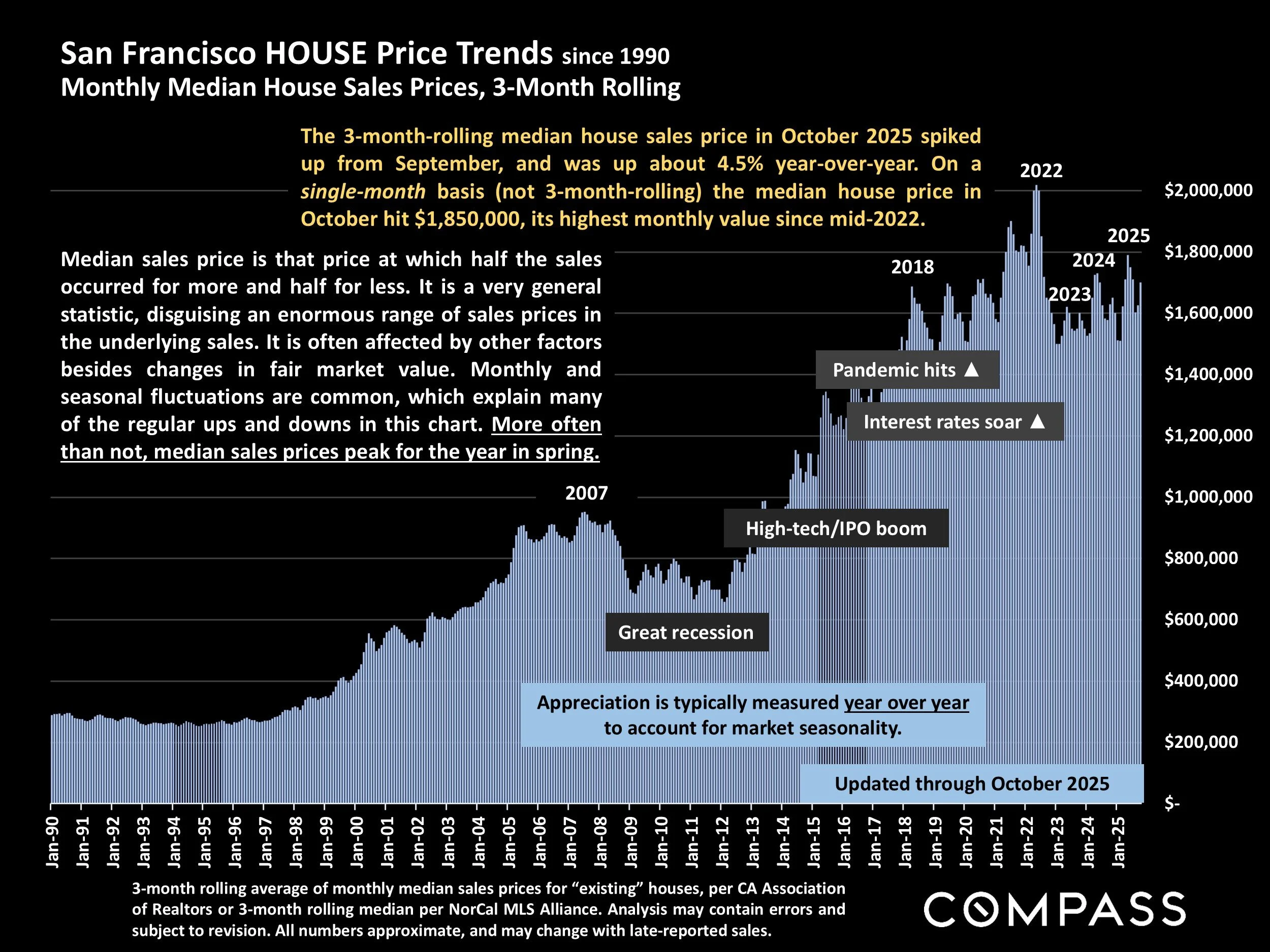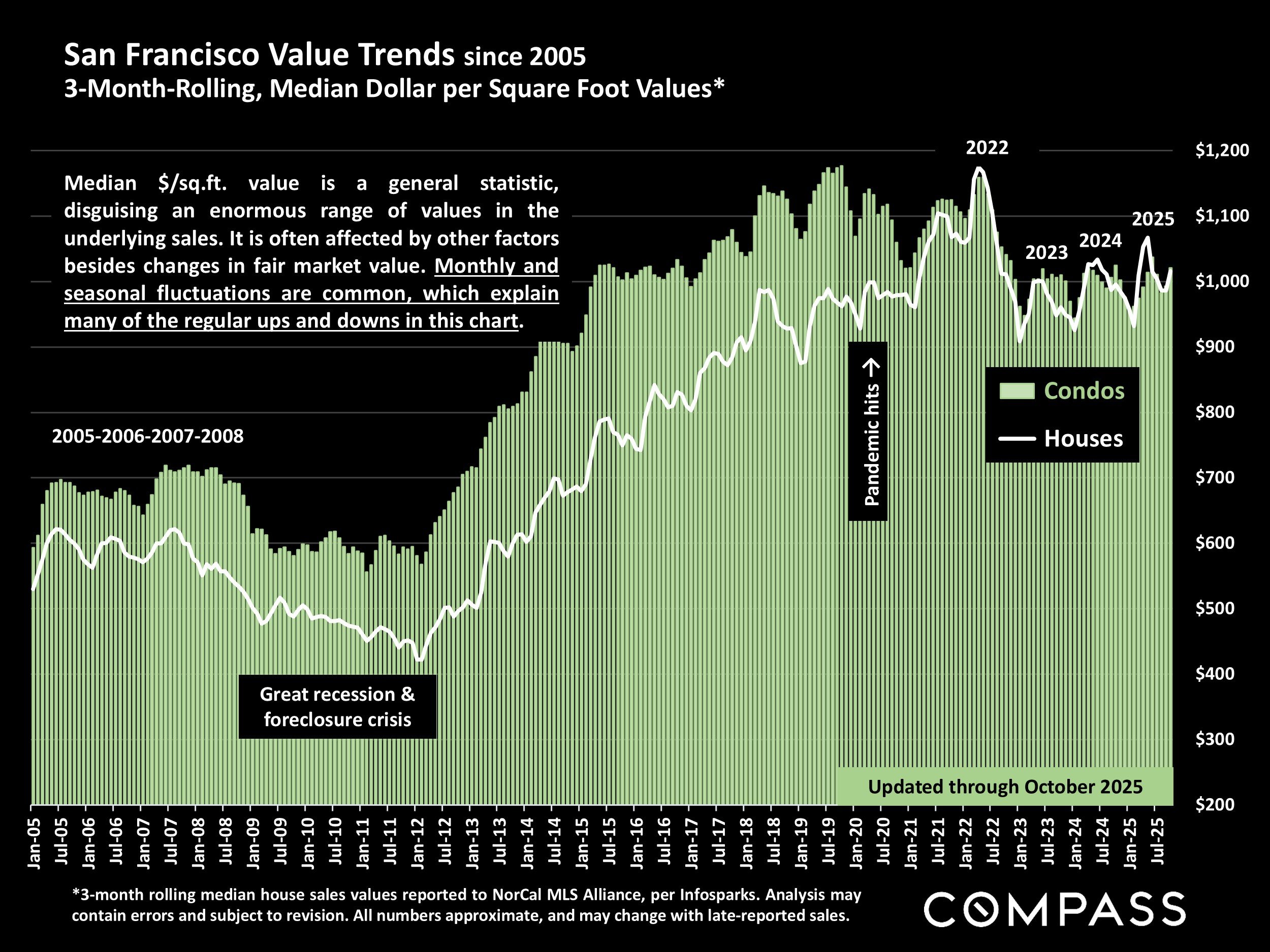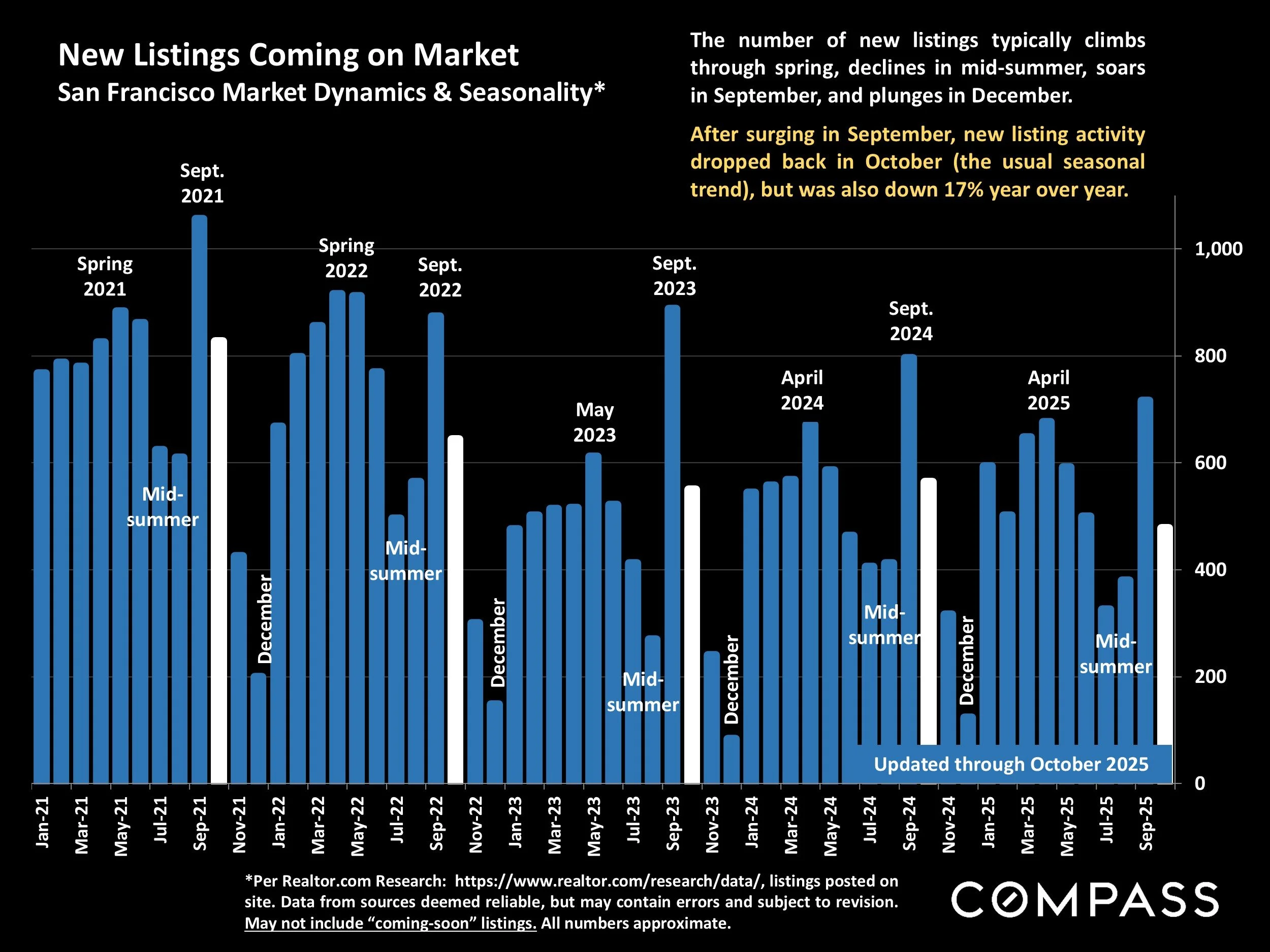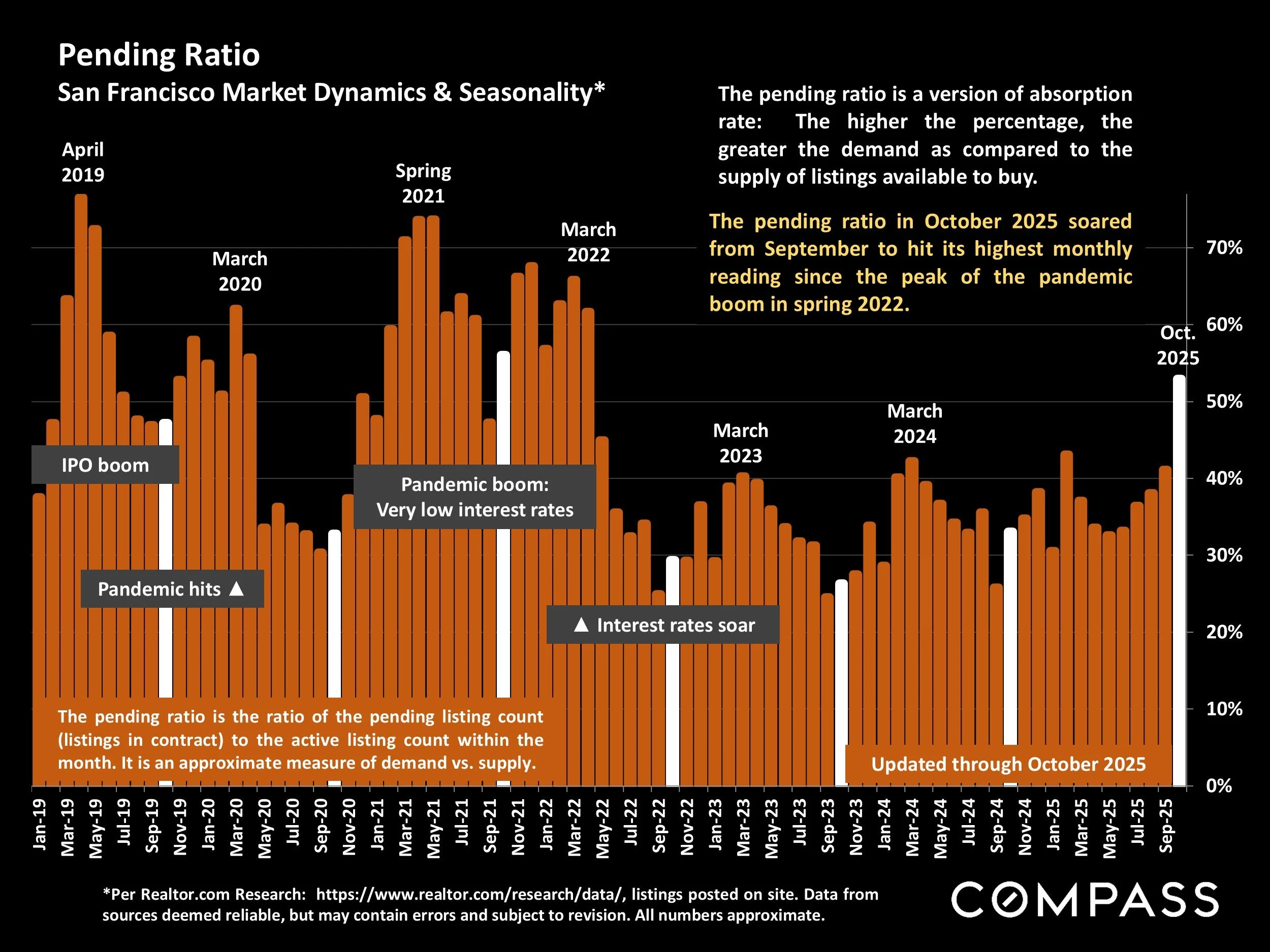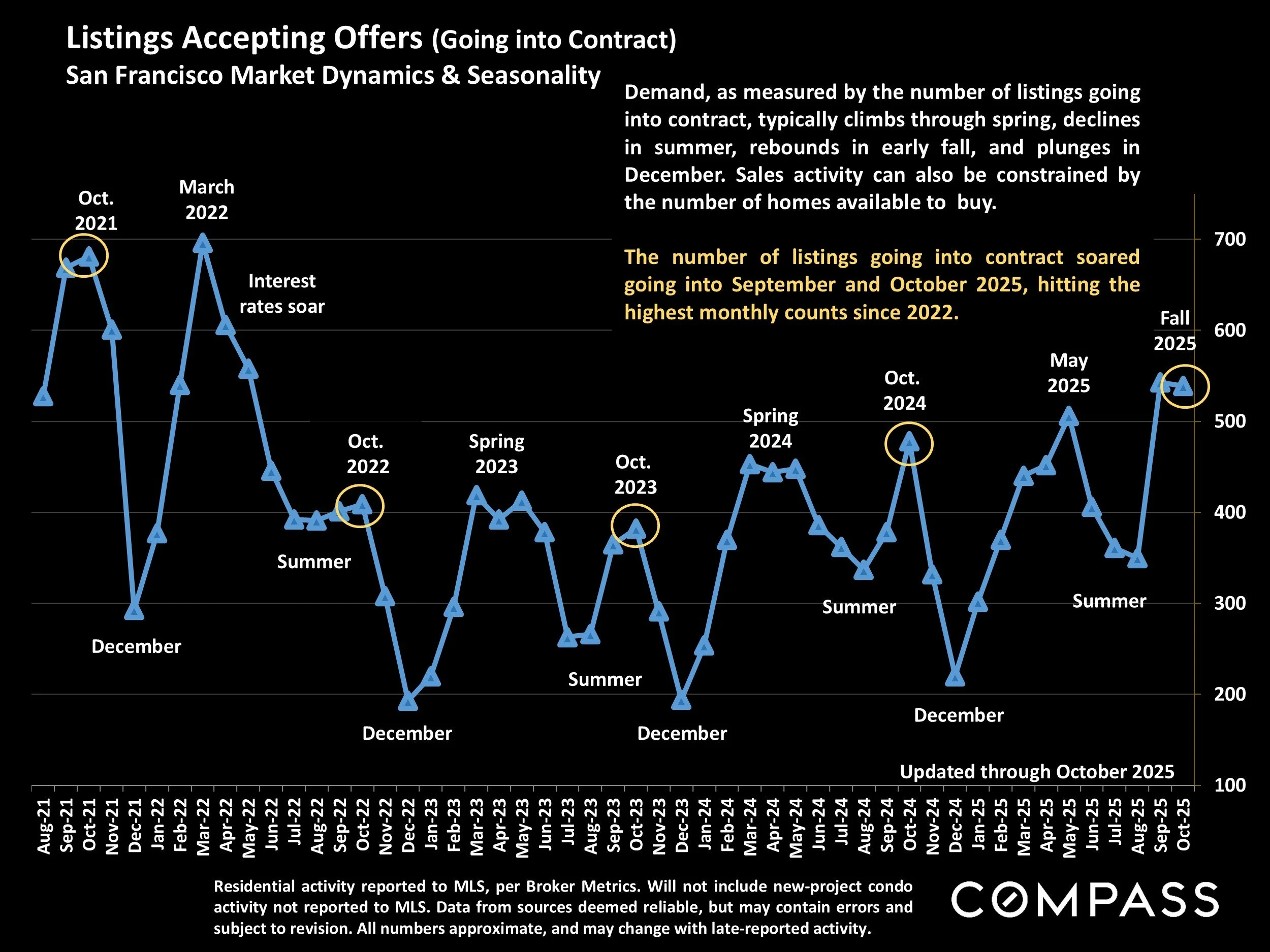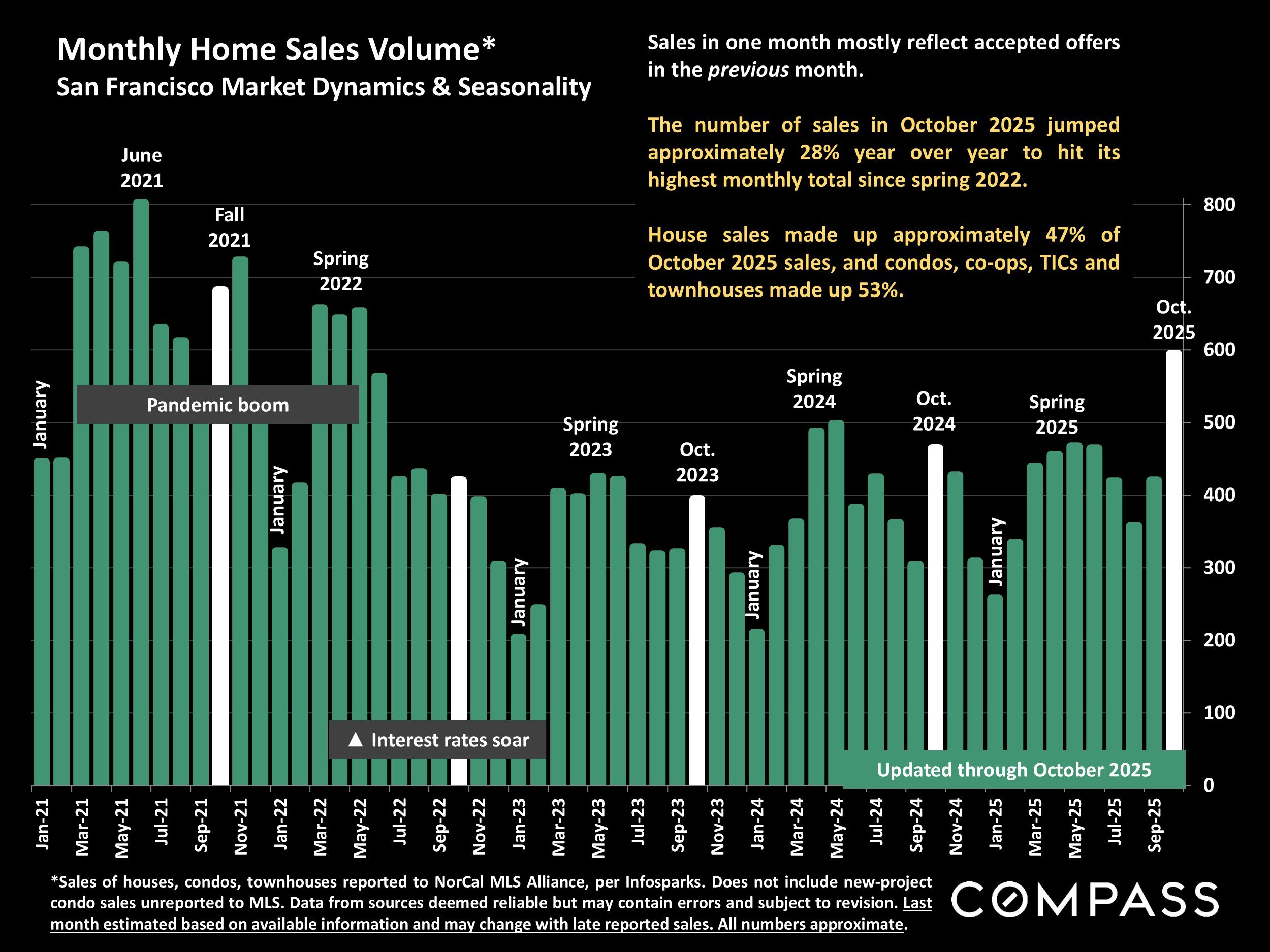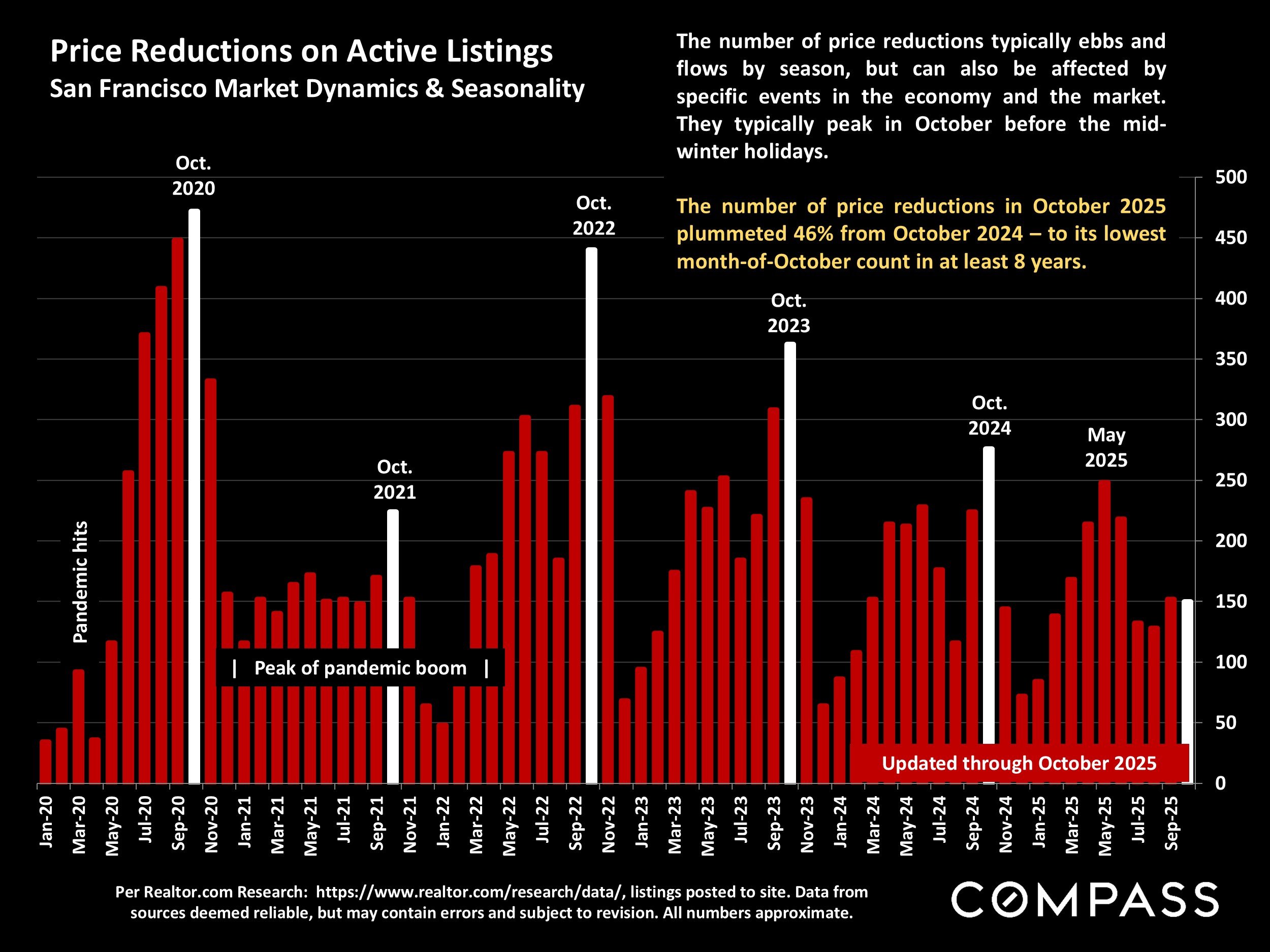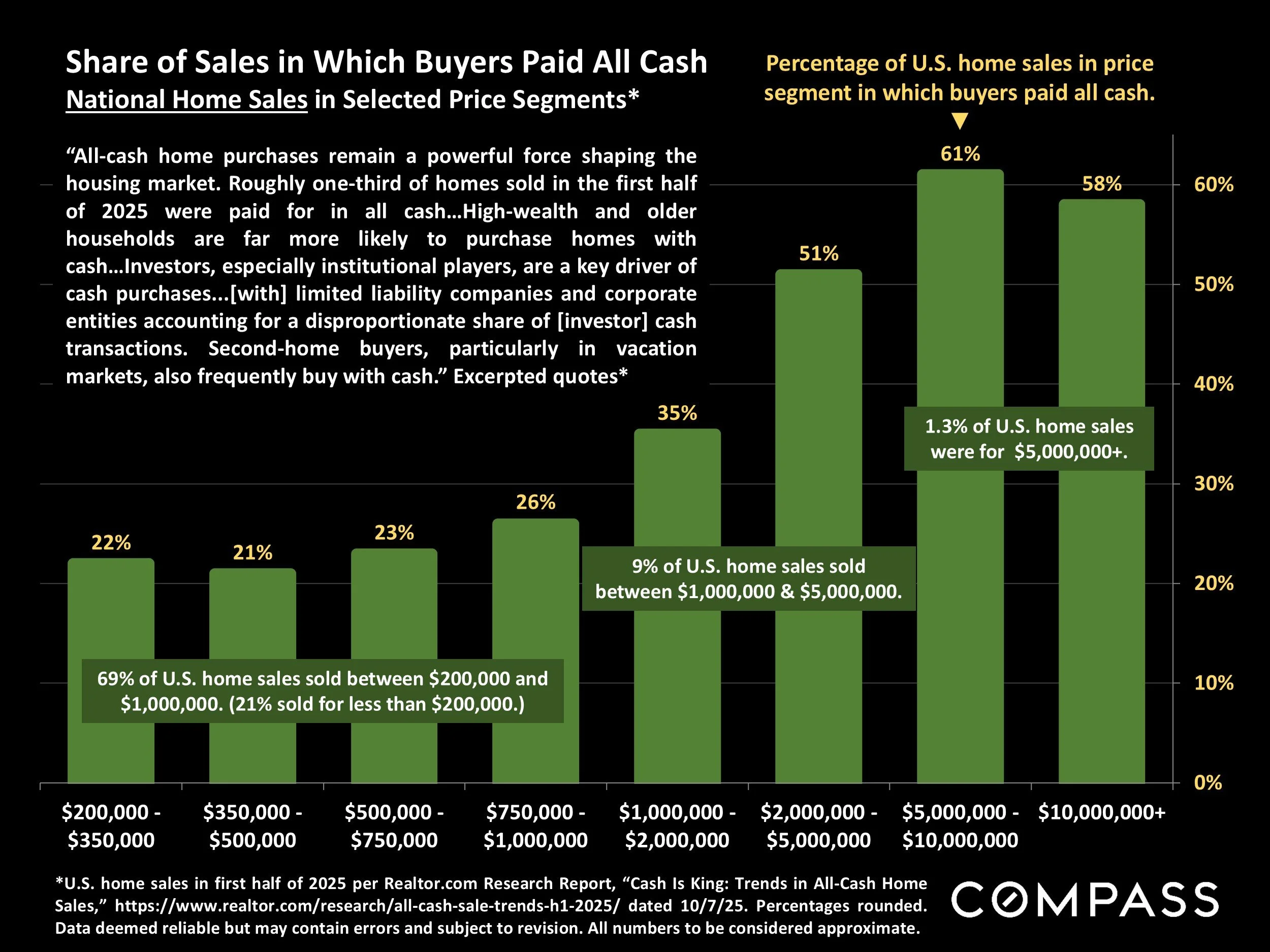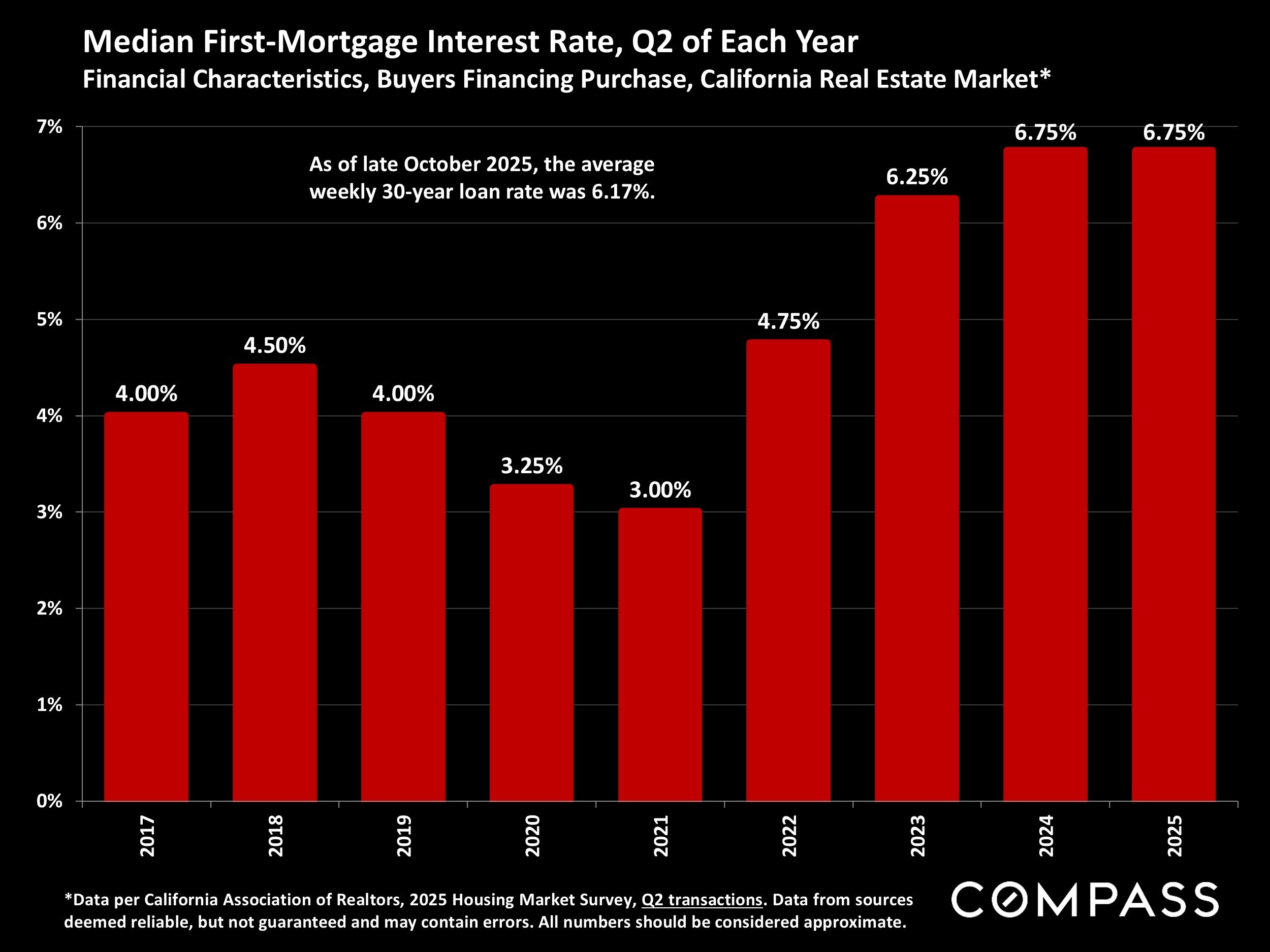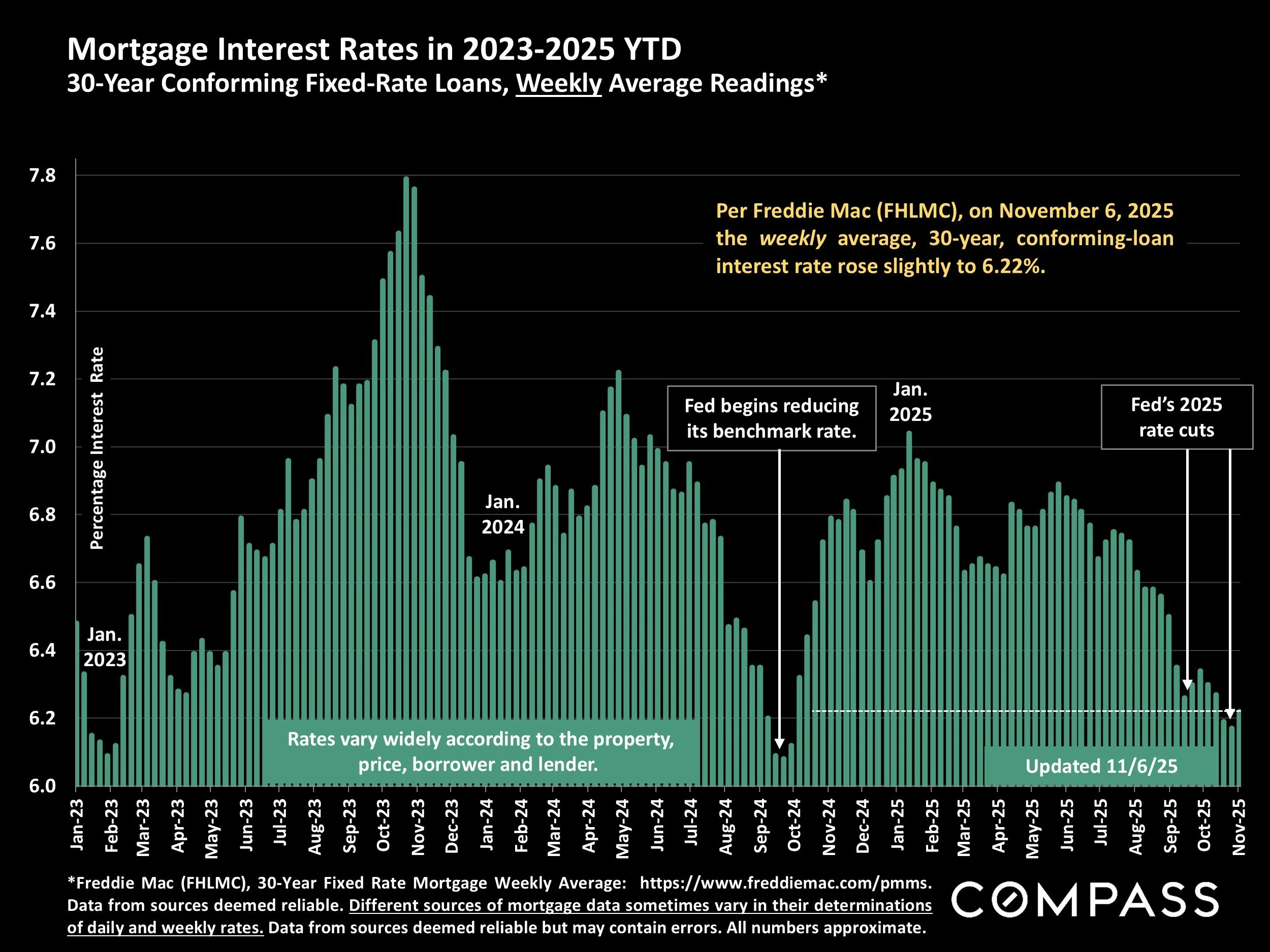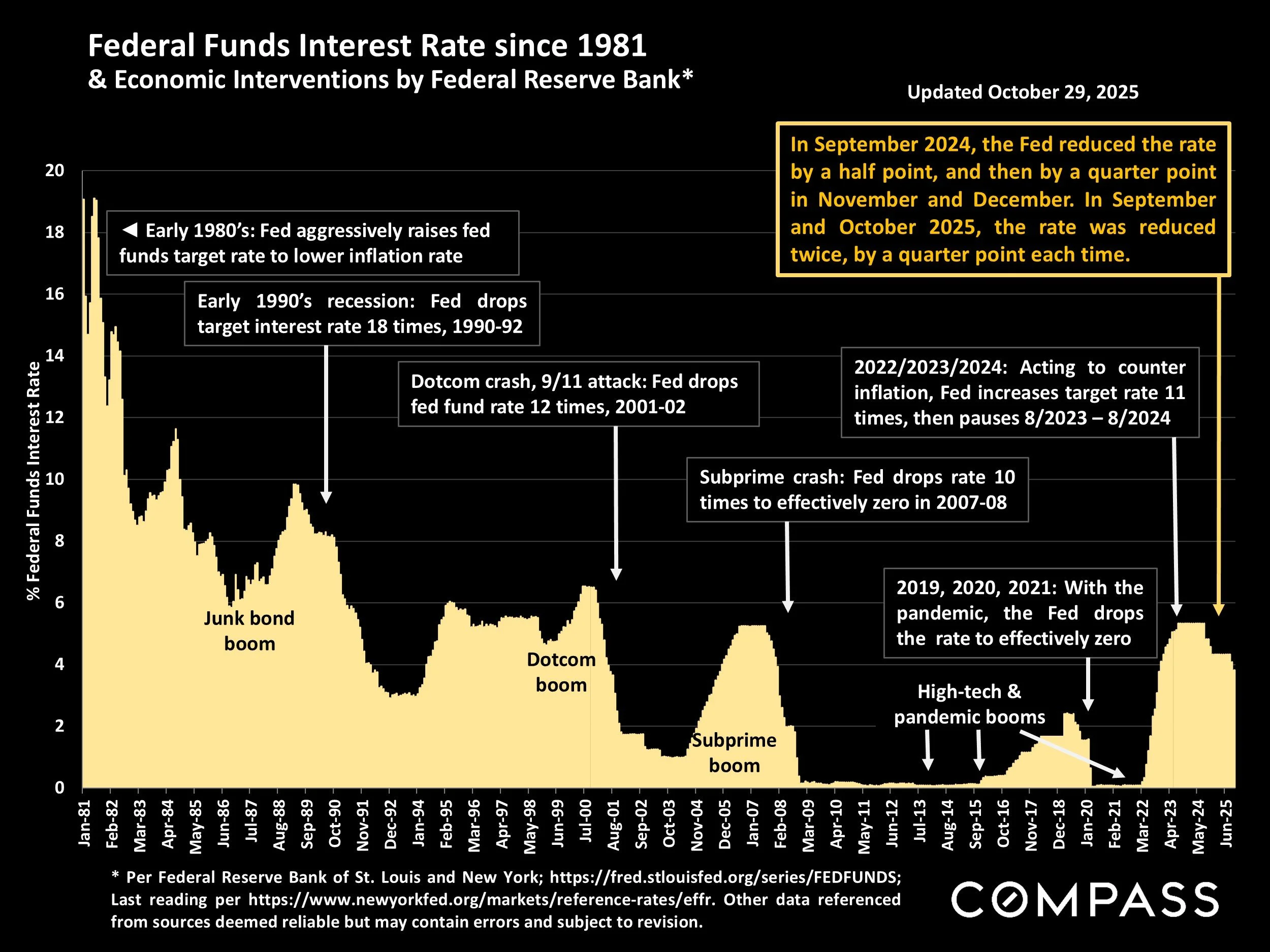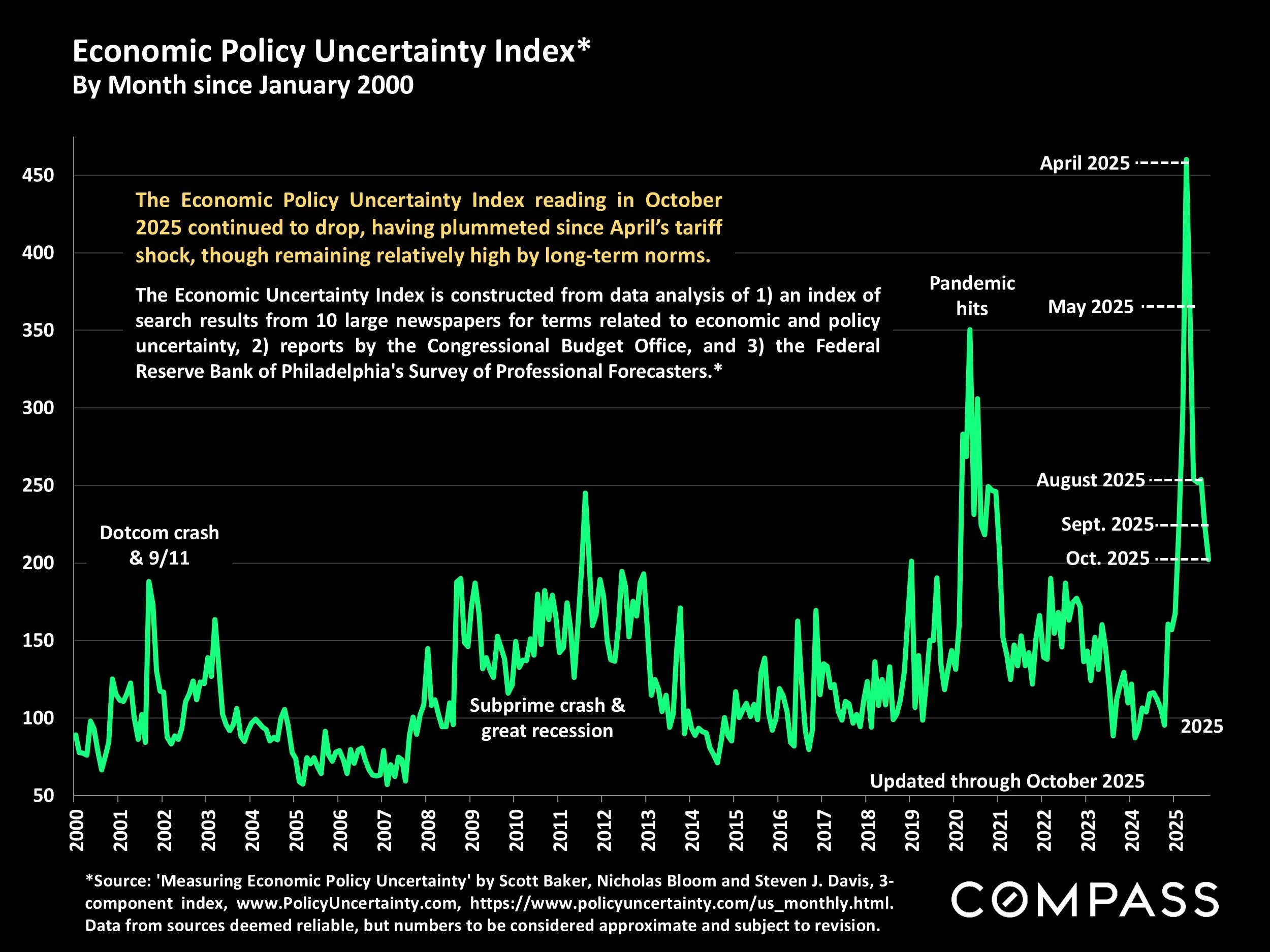November 2025 Market Report
Photo by Cedric Letsch on Unsplash
As of the end of October, the S&P 500 and Nasdaq had reached new highs; 30-year mortgage rates hit their lowest point in over a year; inflation ticked up slightly to 3%; and the Fed made its second .25% reduction of its benchmark rate in 2025 (while cautioning that another reduction in December was not certain). General consumer confidence remained low, with significant unease regarding personal finances, job security and inflation – though affluent consumers enjoying substantial stock market gains were less worried. The Economic Policy Uncertainty Index continued to decline from its tariff-shock peak in April but remained high by long-term norms.
The San Francisco real estate market continues to rapidly accelerate due to the AI startup boom: October's sales hit the highest count since May 2022, while luxury home sales were the best in 4 years. The number of price reductions plummeted 46% on a year-over-year basis, while the pending ratio – a standard measure of market heat – hit its highest monthly reading since the peak of the pandemic boom. 80% of house sales and 44% of condo sales sold for over list price. Virtually all the market indicators point to a dramatic increase in buyer demand competing for a declining number of listings.
The market typically slows from mid-November to mid-January, though it’s possible that this year will buck that trend. In any case, listing and sales activity continue in every month of the year – however, mid-winter is usually the period when buyers can negotiate most aggressively on unsold homes listed earlier in the year.
Report created in good faith using data from sources deemed reliable but may contain errors and subject to revision. Last period figures are preliminary estimates based on data available early in the following month. All numbers approximate, and may change with late-reported activity.
San Francisco HOUSE Price Trends since 1990
Monthly Median House Sales Prices, 3-Month Rolling
3-month rolling average of monthly median sales prices for “existing” houses, per CA Association of Realtors or 3-month rolling median per NorCal MLS Alliance. Analysis may contain errors and subject to revision. All numbers approximate, and may change with late-reported sales.
The 3-month-rolling median house sales price in October 2025 spiked up from September, and was up about 4.5% year-over-year. On a single-month basis (not 3-month-rolling) the median house price in October hit $1,850,000, its highest monthly value since mid-2022.
Median sales price is that price at which half the sales occurred for more and half for less. It is a very general statistic, disguising an enormous range of sales prices in the underlying sales. It is often affected by other factors besides changes in fair market value. Monthly and seasonal fluctuations are common, which explain many of the regular ups and downs in this chart. More often than not, median sales prices peak for the year in spring.
San Francisco CONDO Price Trends since 2005
Median Condo Sales Price, 3-Month Rolling
3-month rolling median condo sales prices reported to NorCal MLS Alliance, per Infosparks. Analysis may contain errors and subject to revision. All numbers approximate, and may change with late-reported sales.
The 3-month-rolling median condo sales price in October 2025 declined by about 3% year-over-year, but appreciation is expected to turn positive in coming months.
Generally speaking, over the last 5-6 years, Bay Area median condo sales prices have not seen the appreciation rates common in house markets.
Median sales price is that price at which half the sales occurred for more and half for less. It is a very general statistic, often affected by other factors besides changes in fair market value. Monthly and seasonal fluctuations are common, and longer-term trends are more meaningful than short-term changes.
San Francisco Value Trends since 2005
3-Month-Rolling, Median Dollar per Square Foot Values*
*3-month rolling median house sales values reported to NorCal MLS Alliance, per Infosparks. Analysis may contain errors and subject to revision. All numbers approximate, and may change with late-reported sales.
Median $/sq.ft. value is a general statistic, disguising an enormous range of values in the underlying sales. It is often affected by other factors besides changes in fair market value. Monthly and seasonal fluctuations are common, which explain many of the regular ups and downs in this chart.
San Francisco CONDO Prices: Downtown vs. Non-Downtown
12-Month-Rolling, Median 2-Bedroom Condo Sales Prices since 2005*
*12-month rolling median condo sales values reported to NorCal MLS Alliance, per Infosparks. Analysis may contain errors and subject to revision. Does not include new-project sales unreported to MLS. All numbers approximate, and may change with late-reported sales.
Comparing median 2-bedroom condo sales prices in the greater Downtown/South of Market/Civic Center area (the center of large-project, new-condo construction, office buildings and high-tech employment) – the blue line – with the rest of San Francisco (mostly smaller, older buildings, in less urban environments) – the green line.Median sales prices also vary widely within these two broad regions.
People Moving Within & Into San Francisco County
Per U.S. Census, 5-Year ACS Data, Single Year Estimates*
❑ Residents Moving Within County: 68,203
❑ Moving In From Another CA County: 32,339 (Mostly from Bay Area counties or greater Los Angeles region)
❑ Moving In From Another State: 18,276
❑ Moving In From Abroad: 10,457
Largest Sources of Out-of-State Migration into County *
| Source | Population |
|---|---|
| Asia (mostly China, India) | 3,173 |
| Europe | 3,117 |
| New York State | 3,018 |
| Oregon | 1,505 |
| Washington State | 1,369 |
| Central America | 1,189 |
| Massachusetts | 1,174 |
| Texas | 1,160 |
| Illinois | 1,132 |
| Canada | 962 |
| South America | 941 |
| Pennsylvania | 805 |
Moving Out of the County
The majority of residents leaving their Bay Area county move within CA. Of those, a majority move to an adjacent Bay Area county or the next one over.
Largest State Destinations for Residents Leaving CA in 2023**
Texas
Arizona
Nevada
Washington
Florida
Oregon
New York
Colorado
Tennessee
Virginia
**Per U.S. Census 1-Year ACS State to State Migration estimates published 10/2024.
Significant 2-way traffic between counties and states is common. Movers can be homeowners, tenants, university students, etc.
Census data is published with a 2-3 year time lag. This is the latest data available as of October 2025.
*Data per U.S. Census, 5-Year American Community Survey 2018-2022 estimates, published 09/2025: “State to County Migration Flows.” All numbers approximate with significant margins of error. Data published with 2-3 year time lag, may contain errors and subject to revision.
San Francisco Residential Market
Comparative Market Dynamics by Price Segment/Property Type
Market indicators can change dramatically from period to period, due to both economic conditions and seasonal trends.
| Price/ Prop. Type | # Listings for Sale* | # Listings in Contract* | Monthly Rate of Sales** | Supply of Inventory*** | Avg. Days on Market** | Sales Over List Price** | |
|---|---|---|---|---|---|---|---|
| Under $1M | 394 | 188 | 112 sales/mo. | 3.5 months | 68 days | 31% | |
| $1M - <$2M | 313 | 167 | 194 sales/mo. | 1.6 months | 34 days | 64% | |
| $2M - <$3M | 101 | 43 | 58 sales/mo. | 1.7 months | 29 days | 68% | |
| $3M - <$5M | 75 | 17 | 30 sales/mo. | 2.5 months | 36 days | 57% | |
| $5M - <$7.5M | 20 | 3 | 6 sales/mo. | 3.3 months | 44 days | 29% | |
| $7.5M - <$10M9 | 24 | 4 | 3.25 sales/mo. | 7.4 months | 55 days | 22% | |
| $10 Million+ | 17 | 7 | 1.7 sales/mo. | 10 months | too few sales | 10% | |
| Houses | 268 | 181 | 190 sales/mo. | 1.4 months | 27 days | 75% | |
| Condos | 549 | 197 | 181 sales/mo. | 3 months | 58 days | 35% | |
| TICs | 71 | 35 | 24 sales/mo. | 3 months | 54 days | 42% | |
| Co-ops | 39 | 9 | 5 sales/mo. | 7.8 months | 78 days | 17% |
*Active/Coming-Soon Listings & Listings in Contract posted to MLS as of 10/31/25. **Sales statistics per last 12 months of sales, i.e. the annualized rate of activity. ***Months Supply of Inventory measures approx. time required to sell listings for sale at estimated annualized rate of sale: Lower readings signify higher demand compared to supply. Market activity typically ebbs and flows to seasonal trends.
Data reported to NorCal MLS Alliance and Infosparks, may contain errors and subject to revision. Not all activity is reported to MLS. All numbers approximate. Statistics based on annualized activity may not apply to current conditions and can be distorted by outlier data (especially in low sales volumes).
New Listings Coming on Market
San Francisco Market Dynamics & Seasonality*
*Per Realtor.com Research: https://www.realtor.com/research/data/, listings posted on site. Data from sources deemed reliable, but may contain errors and subject to revision. May not include “coming-soon” listings. All numbers approximate.
The number of new listings typically climbs through spring, declines in mid-summer, soars in September, and plunges in December.
After surging in September, new listing activity dropped back in October (the usual seasonal trend), but was also down 17% year over year.
Active & Coming-Soon Listings on 1st of Month*
San Francisco Homes Market
* Houses, condos, co-ops, TICs, townhouses: Active/Coming-Soon listings posted to NorCal MLS Alliance. Does not include new-project condos not listed on MLS. Data from sources deemed reliable, but may contain errors and subject to revision. All numbers approximate. The # of active listings changes constantly.
The number of listings for sale on 11/1/25 fell from the previous month, and plunged 30% year over year. 29% of listings were houses, 58% condos, 8% TICs, and 4% co-ops. Listing inventory can be expected to plummet in coming months.*
The # of active listings on a given day is affected by 1) the # of new listings coming on market,how quickly buyers put them into contract, 3) the sustained heat of the market over time, and 4) sellers pulling their homes off the market without selling.
Pending Ratio
San Francisco Market Dynamics & Seasonality*
*Per Realtor.com Research: https://www.realtor.com/research/data/, listings posted on site. Data from sources deemed reliable, but may contain errors and subject to revision. All numbers approximate.
The pending ratio in October 2025 soared from September to hit its highest monthly reading since the peak of the pandemic boom in spring 2022.
The pending ratio is a version of absorption rate: The higher the percentage, the greater the demand as compared to the supply of listings available to buy.
The pending ratio is the ratio of the pending listing count (listings in contract) to the active listing count within the month. It is an approximate measure of demand vs. supply.
Listings Accepting Offers (Going into Contract)
San Francisco Market Dynamics & Seasonality
Residential activity reported to MLS, per Broker Metrics. Will not include new-project condo activity not reported to MLS. Data from sources deemed reliable, but may contain errors and subject to revision. All numbers approximate, and may change with late-reported activity.
The number of listings going into contract soared going into September and October 2025, hitting the highest monthly counts since 2022.
Demand, as measured by the number of listings going into contract, typically climbs through spring, declines in summer, rebounds in early fall, and plunges in December. Sales activity can also be constrained by the number of homes available to buy.
Monthly Home Sales Volume*
San Francisco Market Dynamics & Seasonality
*Sales of houses, condos, townhouses reported to NorCal MLS Alliance, per Infosparks. Does not include new-project condo sales unreported to MLS. Data from sources deemed reliable but may contain errors and subject to revision. Last month estimated based on available information and may change with late reported sales. All numbers approximate.
Sales in one month mostly reflect accepted offers in the previous month.
The number of sales in October 2025 jumped approximately 28% year over year to hit its highest monthly total since spring 2022.
House sales made up approximately 47% of October 2025 sales, and condos, co-ops, TICs and townhouses made up 53%.
San Francisco Luxury Home Sales
Sales Prices of $5,000,000+
Sales reported to NorCal MLS Alliance, per Infosparks. Not all luxury home sales are reported to MLS. Data from sources deemed reliable, but subject to error and revision. All numbers approximate and may change with late-reported sales.
In October 2025, San Francisco had its highest monthly number of $5 million+ home sales in 4 years, surging 44% higher than in October 2024.
Sales in one month mostly reflect accepted offers in the previous month. The market for luxury homes fluctuates by season, with spring and fall typically the most active markets of the year.
Bay Area Luxury Home Sales Volume vs. S&P 500 Index
A Broad Illustration since September 2023*
*12-month-rolling average number of monthly luxury home sales for 11 greater Bay Area Counties as reported to NorCal MLS Alliance, per Infosparks. October 2025 numbers estimated using available data. 12-month-rolling sales data may lag short-term changes. Monthly S&P 500 readings an average of daily readings. Analysis may contain errors and subject to revision. A generalized illustration. All numbers are approximate.
Comparing Bay Area luxury home sales volume with changes in the S&P 500*. ($5 million+ sales in San Francisco, Marin, San Mateo & Santa Clara Counties; $3 million+ sales in other Bay Area Counties.)
Tariff-shock impact on stock markets did not last long enough to significantly affect 12-month-rolling luxury home sales numbers.
Many factors affect luxury-home sales, but over the last 2 years, as stock markets soared, so did Bay Area luxury home sales. During the 2+ year period illustrated, average monthly sales volume in all price segments (not illustrated on this chart) increased by 7 to 8% – following a modest decline in interest rates – while luxury home sales increased by approximately 49% as the S&P 500 rose over 50%.*
Significant changes in economic conditions will typically affect sales volumes in later months.
Bay Area House Sales, 2025 vs. 2023
Changes in Median Sales Values by Home Size*
*Comparing house sales reported to NorCal MLS Alliance through late October of 2023 and 2025 in 10 greater Bay Area Counties. Fixer-uppers excluded. Analysis made in good faith from data from sources deemed reliable, but may contain errors and subject to revision. All numbers should be considered approximate.
In the past 2 years, soaring stock markets caused the wealth of more affluent Bay Area households to rapidly climb, accelerating demand for, and appreciation of, large luxury homes.
Comparing changes in values of median-sized houses in the Bay Area to the appreciation of large (luxury) houses since stock markets began their dramatic upswing in late 2023. Over the period, the appreciation of values for large houses (4000 – 6000 sq.ft.) was approximately double the rate of median-sized houses (1500 – 2000 sq.ft.).*
Price Reductions on Active Listings
San Francisco Market Dynamics & Seasonality
Per Realtor.com Research: https://www.realtor.com/research/data/, listings posted to site. Data from sources deemed reliable, but may contain errors and subject to revision. All numbers approximate.
The number of price reductions in October 2025 plummeted 46% from October 2024 – to its lowest month-of-October count in at least 8 years.
The number of price reductions typically ebbs and flows by season, but can also be affected by specific events in the economy and the market. They typically peak in October before the mid-winter holidays.
San Francisco: Not Every Home Sells
Listings Taken Off Market Without Selling*
* Expired & withdrawn listings, as reported to the SFAR MLS for houses, condos, TICs, co-ops and townhouses, per Broker Metrics. Data from sources deemed reliable but may contain errors and subject to revision. All numbers approximate.
The number of listings taken off the market typically jumps in December, especially in higher price segments. Many will be relisted in the 1st quarter.
Listings are usually taken off market without selling because 1) buyers are unwilling to pay seller’s price, and/or 2) to sit out seasonal slowdowns – such as often occur in mid-summer and mid-winter.
Overbidding List Prices in San Francisco
Percentage of Home Sales Closing over List Price
Sales data reported to NORCAL MLS® ALLIANCE, per Infosparks. Reflecting the percentage of sales closing at sales prices over the final list prices. Data from sources deemed reliable, but may contain errors and subject to revision. All numbers are approximate, and may change with late-reported sales.
Overbidding is generally caused by buyer competition for new listings. The overall overbidding percentage in the latest month was 61% of sales, but for houses alone, it was 80%, and for condos, 44%.
This statistic fluctuates according to seasonal demand trends, and is a lagging indicator of market activity 3-6 weeks earlier.
Average Sales Price to Original List Price Percentage
San Francisco Over/Under Bidding: Market Dynamics & Seasonality
Sales reported to NorCal MLS Alliance, per Infosparks. Data derived from sources deemed reliable, but may contain errors and subject to revision. All numbers approximate, and may change with late-reported sales.
This chart illustrates the average Sales Price to Original List Price Percentage for all residential sales: 8% over list price, the highest overbid % since mid-2022. But overbidding has been more common and dramatic for house sales than for condo sales: For houses alone in October 2025, the average was 14% above list price, and for condos, 2% over list price.
This statistic can be distorted by strategic underpricing strategies by listing agents.
Average Days on Market – Speed of Sale
San Francisco Market Dynamics & Seasonality
Sales reported to NorCal MLS Alliance, per Infosparks. Data derived from sources deemed reliable, but may contain errors and subject to revision. All numbers approximate, and may change with late-reported sales.
This chart illustrates average days on market for all residential sales (35 days in October 2025). But for houses alone, the average was 24 days, and for condos, 48 days.
Measuring how long it takes for sold listings to accept offers. Homes usually sell fastest in spring and early autumn – with the rush of new listings – and slowest in mid-winter (when the inventory of listings is at its oldest). Houses, on average, sell much faster than condos, co-ops and TICs.
Percentage of Buyers Having Difficulties Obtaining Insurance
State of California, 2025 vs. 2023, by Property Location*
*Asked of Buyer’s agents: “Did the buyer have difficulties obtaining fire/homeowners insurance?”
Data per California Association of Realtors, 2025 Housing Market Survey, Q2 transactions. Data from sources deemed reliable, but not guaranteed and may contain errors. All numbers to be considered approximate.
The ability to find comprehensive, affordable homeowner’s insurance continues to be an increasingly serious issue for buyers (and homeowners). In a 2025 survey, 17% of CA real estate agents reported having a transaction terminate due to an inability to do so.
Average Annual Home Insurance Cost for $300,000 in Coverage
Comparative Costs in Selected States, per Bankrate, September 2025*
| STATE | Avg. Annual Cost | STATE | Avg. Annual Cost | STATE | Avg. Annual Cost | ||
|---|---|---|---|---|---|---|---|
| Nebraska | $ 6,366 | Arizona | $ 2,343 | Idaho | $ 1,392 | ||
| Louisiana | $ 6,274 | Michigan | $ 2,266 | Pennsylvania | $ 1,311 | ||
| Florida | $ 5,761 | Illinois | $ 2,174 | Wyoming | $ 1,306 | ||
| Kansas | $ 4,402 | Missouri | $ 2,147 | Hawaii | $ 1,296 | ||
| Texas | $ 4,101 | Georgia | $ 1,979 | Wisconsin | $ 1,287 | ||
| Kentucky | $ 3,643 | New York | $ 1,861 | Utah | $ 1,283 | ||
| Colorado | $ 3,375 | Massachusetts | $ 1,698 | Maine | $ 1,218 | ||
| Mississippi | $ 3,353 | Virginia | $ 1,687 | New Jersey | $ 1,206 | ||
| Minnesota | $ 2,812 | Connecticut | $ 1,677 | Oregon | $ 1083 | ||
| Montana | $ 2,788 | Maryland | $ 1,664 | Nevada | $ 1074 | ||
| North Carolina | $ 2,676 | Indiana | $ 1,657 | New Hampshire | $ 1040 | ||
| Tennessee | $ 2,639 | California | $ 1,632 | Delaware | $ 966 | ||
| South Carolina | $ 2,611 | Washington | $ 1,520 | Alaska | $ 957 | ||
| Rhode Island | $ 2,423 | Washington DC | $ 1,498 | Vermont | $ 816 |
Many factors affect home insurance costs including susceptibility to natural disasters like severe weather events and fire; property construction; local construction costs; and, as in CA, state regulation of insurers. Overall, rates have been rapidly accelerating with increasing damage claims, and often vary enormously between regions of the same state.
*Per Bankrate: https://www.bankrate.com/insurance/homeowners-insurance/homeowners-insurance-cost/#cost-by-state. Rates refreshed September 2025. The average annual home insurance premium for a home with a dwelling coverage amount of $300,000. Will not include flood or earthquake insurance. Data from sources deemed reliable but may contain errors and subject to revision.
Share of Sales in Which Buyers Paid All Cash
National Home Sales in Selected Price Segments*
*U.S. home sales in first half of 2025 per Realtor.com Research Report, “Cash Is King: Trends in All-Cash Home Sales,” https://www.realtor.com/research/all-cash-sale-trends-h1-2025/ dated 10/7/25. Percentages rounded. Data deemed reliable but may contain errors and subject to revision. All numbers to be considered approximate.
Percentage of U.S. home sales in price segment in which buyers paid all cash.
“All-cash home purchases remain a powerful force shaping the housing market. Roughly one-third of homes sold in the first half of 2025 were paid for in all cash…High-wealth and older households are far more likely to purchase homes with cash…Investors, especially institutional players, are a key driver of cash purchases...[with] limited liability companies and corporate entities accounting for a disproportionate share of [investor] cash transactions. Second-home buyers, particularly in vacation markets, also frequently buy with cash.” Excerpted quotes*
Median First-Mortgage Interest Rate, Q2 of Each Year
Financial Characteristics, Buyers Financing Purchase, California Real Estate Market*
*Data per California Association of Realtors, 2025 Housing Market Survey, Q2 transactions. Data from sources deemed reliable, but not guaranteed and may contain errors. All numbers should be considered approximate.
As of late October 2025, the average weekly 30-year loan rate was 6.17%.
Years of Homeownership before Selling
California Real Estate Market since 2000*
*Data per California Association of Realtors, 2025 Housing Market Survey, Q2 transactions. Data from sources deemed reliable, but not guaranteed and may contain errors. All numbers should be considered approximate.
Homeowners have been staying in their homes longer before selling due to the “mortgage lock-in effect” of recent years, but, over the longer term, to the increasing age of the population and of homeowners specifically: Older age groups tend to move much less often than younger segments. This has large ramifications for the market’s supply and demand dynamics, causing significantly fewer listings to be available for purchase at any given time.
Homeowners holding onto their properties longer before selling because:
Low rate on current mortgage
Low property taxes
Capital gains hit
Where can I afford to go?
Remodel and stay
Percentage of Homes Purchased by International Buyers
California Real Estate Market since 2008*
*Data per California Association of Realtors, 2025 Housing Market Survey, Q2 transactions. Data from sources deemed reliable, but not guaranteed and may contain errors. All numbers should be considered approximate.
The percentage of CA homes purchased by foreign buyers (in Q2) continued to decline. Of foreign buyers, the top 3 nations of origin in 2025 were India, Mexico and China. The percentage of buyers from China (13%) in 2025 is down from an average of 29% in 2019 – 2024.
Due to new national immigration and visa policies, the percentage is expected to plunge in the next survey.
Selected Economic Indicators
Mortgage Interest Rates in 2023-2025 YTD
30-Year Conforming Fixed-Rate Loans, Weekly Average Readings*
*Freddie Mac (FHLMC), 30-Year Fixed Rate Mortgage Weekly Average: https://www.freddiemac.com/pmms. Data from sources deemed reliable. Different sources of mortgage data sometimes vary in their determinations of daily and weekly rates. Data from sources deemed reliable but may contain errors. All numbers approximate.
Per Freddie Mac (FHLMC), on November 6, 2025 the weekly average, 30-year, conforming-loan interest rate rose slightly to 6.22%.
Bay Area Home Sales Volume vs. 30-Year Mortgage Interest Rate
A General Illustration since 2016
12-month-rolling average number of monthly home sales as reported to NorCal MLS Alliance for 11greater Bay Area Counties, per Infosparks. 12-month-rolling sales data may lag short-term changes. Monthly mortgage rates are averages of weekly 30-year fixed, conforming loan rates published by FHLMC. Analysis may contain errors and subject to revision. All numbers approximate.
Many factors affect real estate markets, but generally speaking, when interest rates fall, sales volume rises, and vice versa.
Significant changes in interest rates and economic conditions will typically affect sales volumes in later months.
Inflation: Consumer Price Index (CPI), 2021 – 2025 YTD*
Year-over-Year Percentage Change, by Month
*Consumer Price Index for All Urban Consumers: All Items in U.S. City Average [CPIAUCSL], per Federal Reserve Bank of St. Louis; https://fred.stlouisfed.org/graph/?g=8dGq. Data from U.S. Bureau of Labor Statistics. CPIAUCSL is a price index of a basket of goods and services paid by urban consumers. This index includes roughly 88 percent of the total population. Percentages rounded. Data from sources deemed reliable but may contain errors and subject to revision.
The general “CPI-All Items” inflation reading for September 2025 ticked up slightly to 3%. “Core CPI” (all items except food & energy) also came in at 3%.*
Federal Funds Interest Rate since 1981
& Economic Interventions by Federal Reserve Bank*
* Per Federal Reserve Bank of St. Louis and New York; https://fred.stlouisfed.org/series/FEDFUNDS; Last reading per https://www.newyorkfed.org/markets/reference-rates/effr. Other data referenced from sources deemed reliable but may contain errors and subject to revision.
In September 2024, the Fed reduced the rate by a half point, and then by a quarter point in November and December. In September and October 2025, the rate was reduced twice, by a quarter point each time.
Nasdaq Composite Index
Since January 1995
Per https://fred.stlouisfed.org/series/NASDAQCOM. Because of number of data points, not every week has a separate column. Data from sources deemed reliable but may contain errors and subject to revision. For general illustration purposes only.
“The Nasdaq Composite Index is a market capitalization-weighted index of more than 2,500 stocks listed on the Nasdaq stock exchange. It is a broad index that is heavily weighted toward the important technology sector.” Investopedia.com
The Nasdaq hit a new all-time high in late October 2025. The S&P 500 Index, not illustrated here, also hit a new peak. Changes in stock market values have a large impact on housing markets, especially more affluent, higher price segments.
Economic Policy Uncertainty Index*
By Month since January 2000
*Source: 'Measuring Economic Policy Uncertainty' by Scott Baker, Nicholas Bloom and Steven J. Davis, 3-component index, www.PolicyUncertainty.com, https://www.policyuncertainty.com/us_monthly.html. Data from sources deemed reliable, but numbers to be considered approximate and subject to revision.
The Economic Policy Uncertainty Index reading in October 2025 continued to drop, having plummeted since April’s tariff shock, though remaining relatively high by long-term norms.
The Economic Uncertainty Index is constructed from data analysis of 1) an index of search results from 10 large newspapers for terms related to economic and policy uncertainty, 2) reports by the Congressional Budget Office, and 3) the Federal Reserve Bank of Philadelphia's Survey of Professional Forecasters.*
Statistics are generalities, essentially summaries of widely disparate data generated by dozens, hundreds or thousands of unique, individual sales occurring within different time periods. They are best seen not as precise measurements, but as broad, comparative indicators, with reasonable margins of error. Anomalous fluctuations in statistics are not uncommon, especially in smaller, expensive market segments. Last period data should be considered estimates that may change with late-reported data. Different analytics programs sometimes define statistics – such as “active listings,” “days on market,” and “months supply of inventory” – differently: what is most meaningful are not specific calculations but the trends they illustrate. Most listing and sales data derives from the local or regional multi-listing service (MLS) of the area specified in the analysis, but not all listings or sales are reported to MLS and these won’t be reflected in the data. “Homes” signifies real-property, single-household housing units: houses, condos, co-ops, townhouses, duets and TICs (but not mobile homes), as applicable to each market. City/town names refer specifically to the named cities and towns, unless otherwise delineated. Multi-county metro areas will be specified as such. Data from sources deemed reliable, but may contain errors and subject to revision. All numbers to be considered approximate.
Many aspects of value cannot be adequately reflected in median and average statistics: curb appeal, age, condition, amenities, views, lot size, quality of outdoor space, “bonus” rooms, additional parking, quality of location within the neighborhood, and so on. How any of these statistics apply to any particular home is unknown without a specific comparative market analysis.
Median Sales Price is that price at which half the properties sold for more and half for less. It may be affected by seasonality, “unusual” events, or changes in inventory and buying trends, as well as by changes in fair market value. The median sales price for an area will often conceal an enormous variety of sales prices in the underlying individual sales.
Dollar per Square Foot is based upon the home’s interior living space and does not include garages, unfinished attics and basements, rooms built without permit, patios, decks or yards (though all those can add value to a home). These figures are usually derived from appraisals or tax records, but are sometimes unreliable (especially for older homes) or unreported altogether. The calculation can only be made on those home sales that reported square footage.
Compass is a real estate broker licensed by the State of California, DRE 01527235. Equal Housing Opportunity. This report has been prepared solely for information purposes. The information herein is based on or derived from information generally available to the public and/or from sources believed to be reliable. No representation or warranty can be given with respect to the accuracy or completeness of the information. Compass disclaims any and all liability relating to this report, including without limitation any express or implied representations or warranties for statements contained in, and omissions from, the report. Nothing contained herein is intended to be or should be read as any regulatory, legal, tax, accounting or other advice and Compass does not provide such advice. All opinions are subject to change without notice. Compass makes no representation regarding the accuracy of any statements regarding any references to the laws, statutes or regulations of any state are those of the author(s). Past performance is no guarantee of future results.


